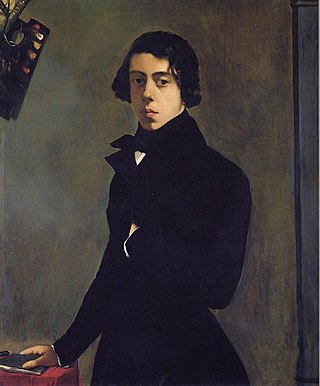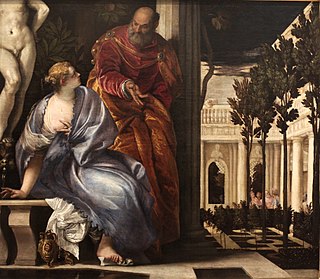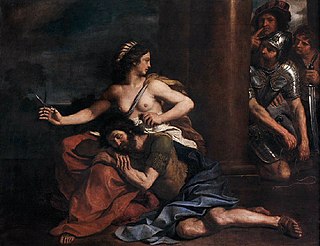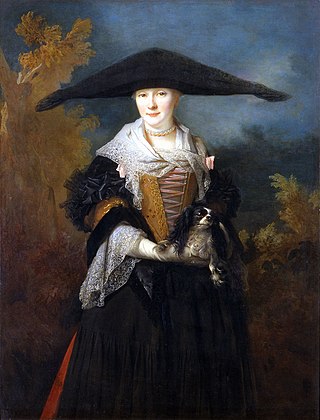
The Louvre, or the Louvre Museum, is a national art museum in Paris, France, and one of the most famous museums in the world. It is located on the Right Bank of the Seine in the city's 1st arrondissement and home to some of the most canonical works of Western art, including the Mona Lisa,Venus de Milo, and Winged Victory. The museum is housed in the Louvre Palace, originally built in the late 12th to 13th century under Philip II. Remnants of the Medieval Louvre fortress are visible in the basement of the museum. Due to urban expansion, the fortress eventually lost its defensive function, and in 1546 Francis I converted it into the primary residence of the French kings.

Jacint Rigau-Ros i Serra, known in French as Hyacinthe Rigaud, was a Catalan-French baroque painter most famous for his portraits of Louis XIV and other members of the French nobility.

Simon Vouet was a French painter who studied and rose to prominence in Italy before being summoned by Louis XIII to serve as Premier peintre du Roi in France. He and his studio of artists created religious and mythological paintings, portraits, frescoes, tapestries, and massive decorative schemes for the king and for wealthy patrons, including Richelieu. During this time, "Vouet was indisputably the leading artist in Paris," and was immensely influential in introducing the Italian Baroque style of painting to France. He was also, according to Pierre Rosenberg, "without doubt one of the outstanding seventeenth-century draughtsmen, equal to Annibale Carracci and Lanfranco."

Théodore Chassériau was a Dominican-born French Romantic painter noted for his portraits, historical and religious paintings, allegorical murals, and Orientalist images inspired by his travels to Algeria. Early in his career he painted in a Neoclassical style close to that of his teacher Jean-Auguste-Dominique Ingres, but in his later works he was strongly influenced by the Romantic style of Eugène Delacroix. He was a prolific draftsman, and made a suite of prints to illustrate Shakespeare's Othello. The portrait he painted at the age of 15 of Prosper Marilhat makes Chassériau the youngest painter exhibited at the Louvre museum.

La Belle Ferronnière is a portrait painting of a lady, by Leonardo da Vinci, in the Louvre. It is also known as Portrait of an Unknown Woman. The painting's title, applied as early as the seventeenth century, identifying the sitter as the wife or daughter of an ironmonger, was said to be discreetly alluding to a reputed mistress of Francis I of France, married to a certain Le Ferron. Later she was tentatively identified as Lucretia Crivelli, a married lady-in-waiting to Duchess Beatrice of Milan, who became another of the Duke's mistresses.

Marie Bracquemond was a French Impressionist artist. She was one of four notable women in the Impressionist movement, along with Mary Cassatt (1844-1926), Berthe Morisot (1841-1895), and Eva Gonzalès (1847-1883). Bracquemond studied drawing as a child and began showing her work at the Paris Salon when she was still an adolescent. She never underwent formal art training, but she received limited instruction from Jean-Auguste-Dominique Ingres (1780–1867) and advice from Paul Gauguin (1848–1903) which contributed to her stylistic approach.

Elisabeth Henriette Marthe Lorimier was a popular portraitist in Paris at the beginning of Romanticism.

René Huyghe was a French writer on the history, psychology and philosophy of art. He was also a curator at the Louvre's department of paintings, a professor at the Collège de France director of the Musée Jacquemart-André, and, beginning in 1960 a member of the Académie Française. He was the father of the writer François-Bernard Huyghe.

Bathsheba at her Bath is an oil-on-canvas painting by Italian Renaissance painter Paolo Veronese, dated around 1575 and now in the Musée des Beaux-Arts de Lyon, France.
Jean-Charles Tardieu, also called "Tardieu-Cochin" was a successful French painter during the ages of Napoleon and of the Bourbon Restoration. His work was primarily historical, but also included landscapes, portraits and religious subjects.

Philippe-Auguste Jeanron was a French painter, curator and writer. Throughout his life he was a passionate republican. His genre pictures typically depicted common people. He opposed the July Monarchy. After the February Revolution of 1848 was made head of National Museums and Director of the Louvre, where he introduced important innovations in the preservation, classification and arrangement of the collections. Later he became director of the museum in Marseilles.

La Circassienne au Bain, also known as Une Baigneuse, was a large Neoclassical oil painting from 1814 by Merry-Joseph Blondel depicting a life-sized young naked Circassian woman bathing in an idealized setting from classical antiquity. The painting was lost with the sinking of the RMS Titanic in 1912. When financial compensation claims were filed with US commissioner Gilchrist in January 1913, the painting gained notoriety as the subject of the largest claim made against the White Star Line for the loss of a single item of baggage or cargo.

Auguste-Xavier Leprince was a French artist and painter who attained celebrity at the age of seventeen. His patrons included the Duchesse de Berry, Charles X, and Alexandre du Sommerard. He was also a teacher; in his twenties he established his own atelier in Paris, with pupils including his two younger brothers, Robert-Léopold and Pierre-Gustave, as well as Eugène Lepoittevin and Nicolas Alexandre Barbier. His meteoric career came to an abrupt end and his "brilliant promise was cut short by his premature death at the age of twenty-seven."

La Toilette, also known as Rousse, is an painting by Henri de Toulouse-Lautrec, from 1889. The painting depicts a red-headed woman, stripped to the waist, seated on the floor, facing away from the viewer, just before or just after bathing. Held by public collections in France since 1914, it has been at the Musée d'Orsay, in Paris, since 1983.

Portrait of Marguerite de Conflans is a c.1876 oval oil on canvas portrait by the French painter Édouard Manet. It is owned by the Musée d’Orsay, though it is on display in the red salon at the Musée des Augustins in Toulouse. Like A Bar at the Folies-Bergère, the work mimics Ingres in its use of a mirror to show the figure from several angles, a motif rarely used by Manet.
Jean-Baptiste Goyet or J.-B. Goyet was a self-taught French artist. Beginning in 1827 his work was regularly selected for exhibition in the annual Paris Salon. His genre paintings—variously sentimental, satirical, or historical—reached a wide audience through reproductions using the then-new medium of lithography. His son, Eugène Goyet (1798-1857), also became a painter, with a career that surpassed that of his father. Eugène's wife, Zoé, was also an artist.

Samson and Delilah is a 1654 painting by the Italian Baroque painter Giovanni Francesco Barbieri. It is on display in the Musée des Beaux-Arts of Strasbourg, France. Its inventory number is 316.

Cephalus and Procis is a 1580s painting by the Italian Renaissance painter Paolo Veronese. It is on display in the Musée des Beaux-Arts of Strasbourg, France. Its inventory number is 634.

La Belle Strasbourgeoise is a 1703 painting by the French painter Nicolas de Largillière. It is now in the Musée des Beaux-Arts of Strasbourg, France. Its inventory number is 2146.

Supper at Emmaus is a painting by Italian Renaissance artist Paolo Veronese. At the Louvre, where it is housed, it is known as Les Pèlerins d'Emmaüs. Painted circa 1559 or 1560, it is a reworking of the Gospel story of the resurrected Jesus's appearance in Emmaus as a 16th-century Venetian family gethering.


















